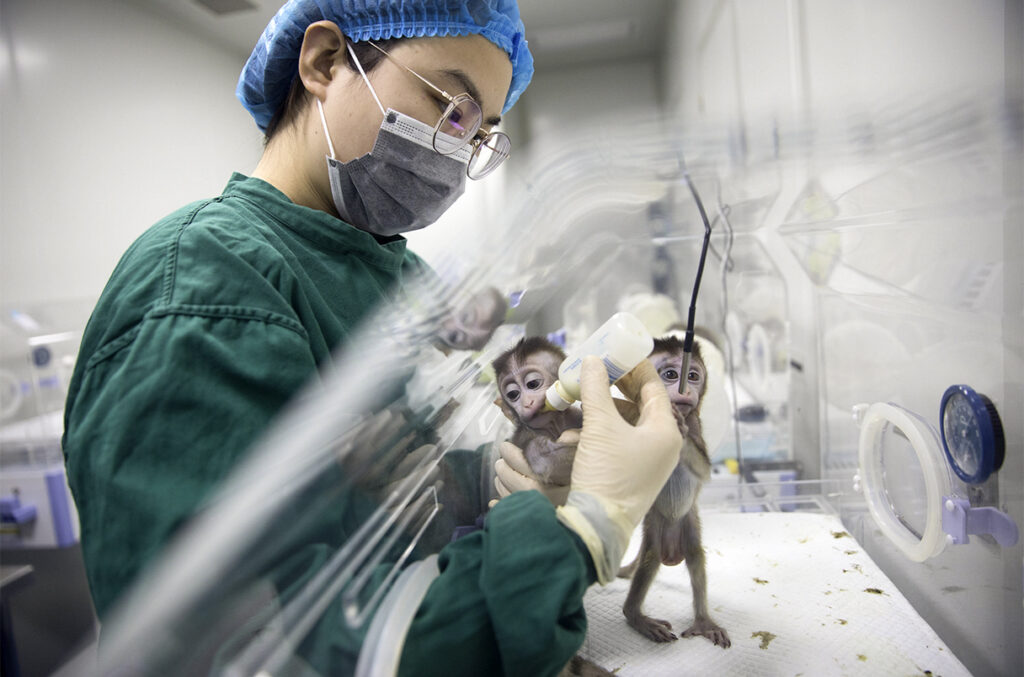中国は大規模な資金注入とサル研究への開放性で脳研究に大きな賭けをしている-7億4600万ドルの野心的なプログラムは、ヨーロッパと米国における大規模な神経科学プロジェクトを補完することを目的としている-
After 5 years of planning and debate, China has finally launched its ambitious contribution to neuroscience, the China Brain Project (CBP). Budgeted at 5 billion yuan ($746 million) under the latest 5-year plan, the CBP will likely get additional money under future plans, putting it in the same league as the U.S. Brain Research Through Advancing Innovative Neurotechnologies (BRAIN) Initiative, which awarded $2.4 billion in grants through 2021, and the EU Human Brain Project, budgeted at $1.3 billion. The project “is really on the move,” says one of its architects, neuroscientist Mu-ming Poo, head of the Chinese Academy of Sciences’s (CAS’s) Institute of Neuroscience (ION).
The details of the project remain murky. But China’s researchers “seem to be building on their strengths, which is great,” says neuroscientist Robert Desimone of the Massachusetts Institute of Technology, who collaborates with colleagues in China. The CBP focuses on three broad areas: the neural basis of cognitive functions, diagnosing and treating brain disorders, and brain-inspired computing. Monkey studies will play a key part in the research, and project leaders hope the virtual absence of animal rights activism in China will help lure talent from overseas. (Poo himself studied and worked in the United States for 40 years, including a decade at the University of California, Berkeley, and moved to China full-time in 2009.)
Neuroscience was first identified as a priority in China’s 2016 Five-Year Plan, but soon became “a very contentious project,” says Denis Simon, a China science policy expert at Duke University. “There was hefty debate and discussion about how to choose projects, set priorities, and allocate funds,” Simon says. Deliberations dragged on until brain science was again designated as a priority field in the 2021 Five-Year Plan, adopted in March 2021. Funding for the CBP finally started to flow in December 2021, Poo says.
The acrimony continued. The money will be shared among 11 designated centers and about 50 research groups selected by an organizing committee that Poo heads. Neurobiologist Yi Rao, president of Capital Medical University, told Science all 11 selected institutes are represented on the committee, which creates conflicts of interest. “Everyone tends not to oppose the targeted projects proposed by others, so that the projects they support can also be adopted smoothly,” he wrote in a 23 January social media post. Poo declined to comment on the criticism; several other neuroscientists in China did not answer emails seeking comment on the CBP.
Who will benefit most from the plan is hard to determine. Science could not find any official announcements of the awards to designated centers or grant recipients, and Poo declined to provide such numbers. Calls to China’s Ministry of Science and Technology seeking information proved futile.
Still, Desimone says it’s clear that the CBP, with its focus on treatments and basic work with primates, complements the EU and U.S. schemes. The BRAIN Initiative, announced in 2013, is more focused on tools and technologies. Europe’s Human Brain Project started off, also in 2013, as a plan to build a computer model of the human brain, although its research objectives were broadened after that goal was criticized as unrealistic.
One Chinese strength the CBP plans to expand on is imaging. A group led by Qingming Luo, president of Hainan University, has refined and automated a technique named fluorescence micro-optical sectioning tomography (fMOST) to slice and image microns-thick ribbons of tissue from blocks of mouse brains. Computers reconstruct the data into 3D views of neurons and their connections. fMOST “provided a foundational data set for understanding and identifying the diverse cell types in the mouse brain,” says Hongkui Zeng, director of the Allen Institute for Brain Science, which is collaborating with the U.S. BRAIN Initiative.
Now, Luo’s team plans to do the same for the macaque brain, which is 200 times bigger, aiming to produce a “mesoscale connectome”—something like a wiring diagram. The effort will complement new brain-mapping programs under the BRAIN Initiative, says the initiative’s director, John Ngai of the U.S. National Institutes of Health. He and Poo are discussing cooperation.
China is already a leader in another CBP focus area, the development of disease models in monkeys. Poo’s team made headlines in 2019 by combining cloning with gene editing to produce five genetically identical macaques that lacked a key gene regulating the circadian clock. The cloning proved inefficient; the group used 325 gene-edited embryos and 65 surrogate females to create the five animals. But the gene deletion had dramatic effects: The animals exhibit sleep disorders, increased anxiety, and depression. Poo’s group has also used gene editing to produce monkeys predisposed to Alzheimer’s disease. Other ION researchers are developing techniques for crippling genes in monkeys to induce symptoms of amyotrophic lateral sclerosis, says Stanford University neuroscientist Aaron Gitler, who studies ALS and has spent the past year on sabbatical at ION.
Poo intends to share his team’s animal models. But because major airlines no longer carry nonhuman primates as cargo, researchers will have to visit the International Center for Primate Brain Research, which receives funding from the city of Shanghai and CAS and is not part of the CBP. The center is led by Poo and neuroscientist Nikos Logothetis, who over the past 2 years moved most of his team from the Max Planck Institute for Biological Cybernetics after his lab was targeted by animal rights activists.
Logothetis, who declined an interview request, is unlikely to have similar problems in China. “There is some but not a lot of concern about animals used in research, but there is no animal rights group focusing on this area,” says Deborah Cao, an animal law and welfare expert at Griffith University, Nathan. Still, Chinese researchers are striving to “replace, reduce, and refine” animal experiments, says Ji Dai, a neuroscientist at CAS’s Shenzhen Institutes of Advanced Technology. Even in China, policies on handling animals are getting stricter, he says.
For now, China is expanding the number of nonhuman primates in its research centers. The Kunming Institute of Zoology is completing a new facility that, with space for 5000 monkeys, will be China’s largest, says Bing Su, a geneticist there. CAS institutes in Shanghai already have more than 1000 animals and may double or triple that number, Poo says. He adds a monkey breeding and research center in Hainan province may hold 20,000 animals a decade from now. For comparison, the United States’s seven National Primate Research Centers hold 18,000 to 20,000 nonhuman primates.
The CBP may face other challenges. China’s stringent zero–COVID-19 policy has led to draconian control measures; Shanghai, one of China’s top research cities, shut down entirely in April and May. Such restrictions have “expats bailing out of China,” Gitler says. “We’ll see how that affects the ability of Mu-ming and others to recruit people.”
Another question is whether political friction between China and the West will dent cooperation. Desimone sees little impact on life science collaborations at the moment. “But I don’t have a crystal ball about international tensions in the future,” he says.
5年にわたる計画と議論の末、中国はついに神経科学への野心的な貢献である中国脳プロジェクト(CBP)を開始した。最新の5年計画では50億元(7億4600万ドル)の予算が組まれましたが、CBPは今後の計画で追加資金を得る可能性が高く、2021年までに24億ドルの助成金を授与した米国のBrain Research Through Advancing Innovative Neurotechnologies (BRAIN) Initiativeや、13億ドルの予算のあるEU Human Brain Projectなどと同じレベルのプロジェクトになります。このプロジェクトの立役者の一人、中国科学院(CAS)神経科学研究所(ION)所長の神経科学者ムーミン・プー(蒲 慕明)博士は、「本当に動き出しています」と言う。
このプロジェクトの詳細はまだ不明である。しかし、中国の研究者たちは「自分たちの強みを生かしているようで、素晴らしいことだ」と、中国の同僚と共同研究を行っているマサチューセッツ工科大学の神経科学者ロバート・デシモンは言う。CBPは、認知機能の神経基盤、脳疾患の診断と治療、脳に着想を得たコンピューティングという3つの大きな分野に焦点を当てている。この研究では、サルの研究が重要な役割を果たす。プロジェクトのリーダーは、中国には動物愛護主義がほとんどないため、海外から人材を呼び込むのに役立つと期待している。(プー自身も、カリフォルニア大学バークレー校での10年間を含め、40年間米国で研究・仕事をしてきましたが、2009年に中国に本格的に移住しました)。
神経科学は、中国の2016年5カ年計画で初めて優先課題に挙げられたが、すぐに「非常に議論の多いプロジェクト」になったと、デューク大学の中国科学政策専門家Denis Simonデニス・サイモンは言う。「プロジェクトをどう選び、優先順位を決め、資金をどう配分するかについて、膨大な議論と議論がありました」とサイモンは言う。2021年3月に採択された「2021年5カ年計画」で脳科学が再び優先分野として指定されるまで、審議は長引いた。2021年3月に採択された2021年5カ年計画で、脳科学が再び重点分野に指定されるまで審議は長引き、2021年12月にようやくCBPへの資金提供が開始されたとプーは言う。
険悪な状態が続いた。資金は11の指定センターと、Pooが主宰する組織委員会が選んだ約50の研究グループに分配される。首都医科大学の神経生物学者Rao Yiイー・ラオ学長は、選ばれた11の研究機関すべてが委員会の代表であり、利益相反が生じるとサイエンス誌に語った。「誰もが、他の人が提案した対象プロジェクトに反対しない傾向があり、自分が支持するプロジェクトもスムーズに採択されるようになる」と、1月23日のソーシャルメディアに書き込んでいる。プー氏はこの批判についてコメントを避けた。中国の他の神経科学者数名は、CBPについてコメントを求める電子メールに回答していない。
この計画の恩恵を最も受けるのは誰なのか、判断するのは難しい。サイエンス誌は、指定されたセンターや助成金受領者に対する賞の公式発表を見つけることができず、プー氏はそのような数字の提示を拒否した。中国科学技術省に電話しても情報は得られなかった。
しかし、Robert Desimone – MIT McGovern Instituteは、霊長類を用いた治療と基礎研究に重点を置くCBPが、EUと米国の計画を補完するものであることは明らかだと述べている。2013年に発表されたBRAIN Initiativeは、よりツールや技術に重点を置いています。欧州のヒューマン・ブレイン・プロジェクトは、人間の脳のコンピュータモデルを構築する計画として2013年にスタートしたが、この目標は非現実的であると批判されたため、研究目的を拡大した。
CBPが拡大する予定の中国の強みは、イメージングである。海南大学の羅清明学長が率いるグループは、マウスの脳ブロックからミクロン単位の厚さのリボンのような組織をスライスして画像化する蛍光マイクロ光学切断トモグラフィ(fMOST)という技術を改良し自動化している。fMOSTは、「マウスの脳の多様な細胞タイプを理解し、識別するための基礎となるデータセットを提供してくれました」と、米国BRAIN Initiativeに協力しているAllen Institute for Brain ScienceのHongkui Zeng所長は述べている。
ルオの研究チームは、200倍も大きいマカクの脳についても同様の研究を行い、「メソスケールコネクトーム」(配線図のようなもの)を作成することを計画している。BRAIN Initiativeのディレクターである米国国立衛生研究所のジョン・ガイ氏によれば、この研究はBRAIN Initiativeの下で行われている新しい脳マッピングプログラムを補完するものになるという。ガイとプーは協力について議論している。
中国は、CBPのもうひとつの重点分野であるサルの疾患モデル開発において、すでにリーダー的存在となっている。プーのチームは2019年、クローニングと遺伝子編集を組み合わせ、概日時計を制御する重要な遺伝子を欠いた、遺伝的に同一のマカクを5匹作製し、大きな話題となった。クローニングは効率が悪いことが判明し、研究グループは5匹の動物を作るために325の遺伝子編集胚と65の代理の雌を使用した。しかし、この遺伝子の欠失は劇的な効果をもたらした。睡眠障害、不安の増大、うつ病などが見られるようになったのである。プーのグループは、遺伝子編集を利用してアルツハイマー病の素因を持つサルを作製したこともある。スタンフォード大学の神経科学者であるアーロン・ギトラーは、ALSの研究をしており、この1年間はIONで研究休暇を過ごしている。
プーは自分のチームの動物モデルを公開するつもりである。しかし、大手航空会社では霊長類を貨物として扱わないため、研究者は上海市とCASから資金提供を受けている国際霊長類脳研究センター(CBPに属さない)を訪れなければならない。このセンターは、プーと神経科学者のニコス・ロゴテティスが率いています。彼は、過去2年間、マックス・プランク生物学サイバネティクス研究所が動物権利活動家の標的となったため、彼のチームのほとんどを移転させました。
ロゴテティス氏はインタビューの要請を断ったが、中国でも同じような問題が起こる可能性は低い。グリフィス大学(ネイサン)の動物法・福祉専門家であるデボラ・カオ氏は、「研究に使われる動物に対する懸念は多少あるが、この分野に焦点を当てた動物権利団体は存在しない」と言う。それでも中国の研究者は、動物実験を「代替、削減、改良」しようと努力していると、CASの深セン先進技術研究所の神経科学者、ジー・ダイは言う。中国国内でも、動物の取り扱いに関する政策は厳しくなってきているという。
今のところ、中国は研究センターにおける非ヒト霊長類の数を増やしている。昆明動物学研究所は新しい施設を完成させ、5000匹のサルを収容できる中国最大の施設になると、同研究所の遺伝学者であるBing Suは言う。上海のCAS研究所はすでに1000匹以上のサルを飼育しており、その数は2倍、3倍になるかもしれないとプー氏は言う。また、海南省のサル飼育研究センターでは、10年後には2万匹になるかも知れないという。ちなみに、米国の7つの国立霊長類研究センターでは、18,000から20,000頭の霊長類が飼育されている。
CBPは他の課題にも直面するかもしれない。中国の厳しいゼロCOVID-19政策により、厳しい管理体制が敷かれており、中国有数の研究都市である上海は、4月と5月に全面的に閉鎖された。このような規制により、「外国人は中国から逃げ出した」とGitlerは言う。「このことが、Mu-mingらの人材確保にどう影響するかは、これからです」。
もう一つの疑問は、中国と欧米の政治的摩擦によって協力関係が損なわれないかということだ。デシモンは、今のところライフサイエンスの共同研究への影響はほとんどないと見ている。「しかし、私は将来の国際的緊張について水晶玉を持っているわけではありません」と彼は言う。

